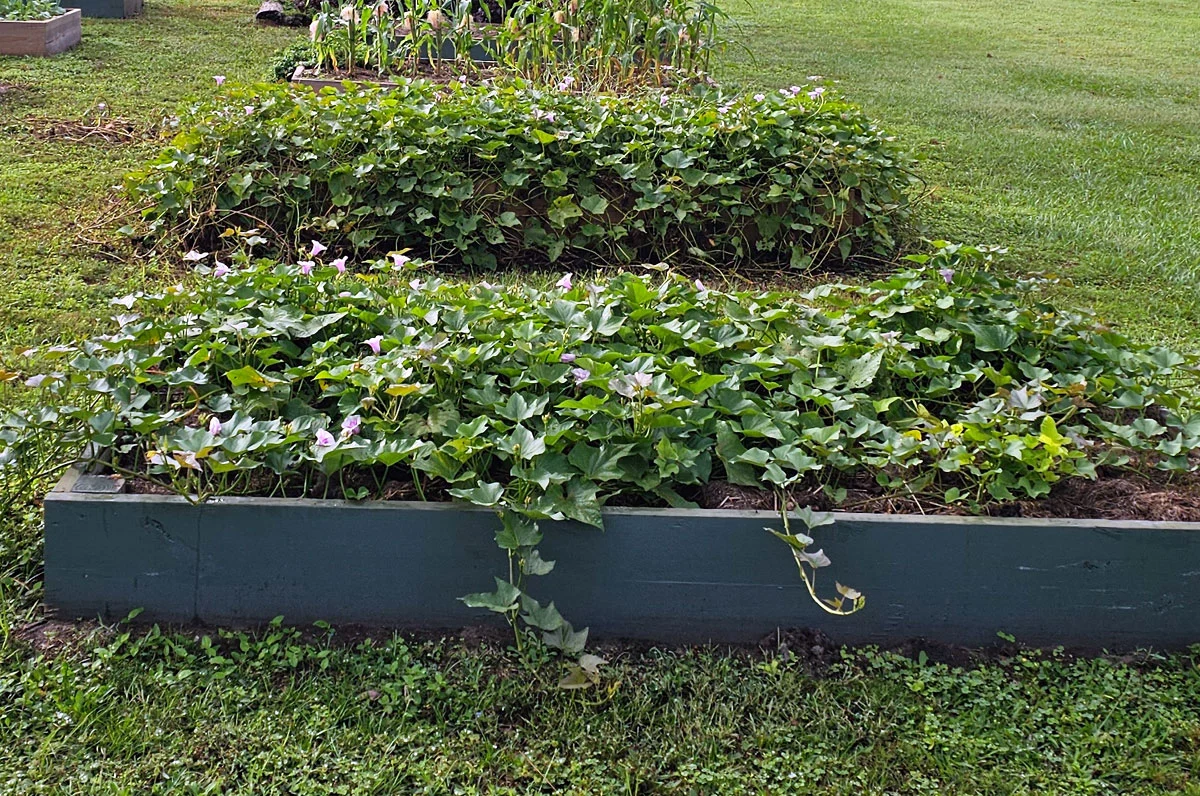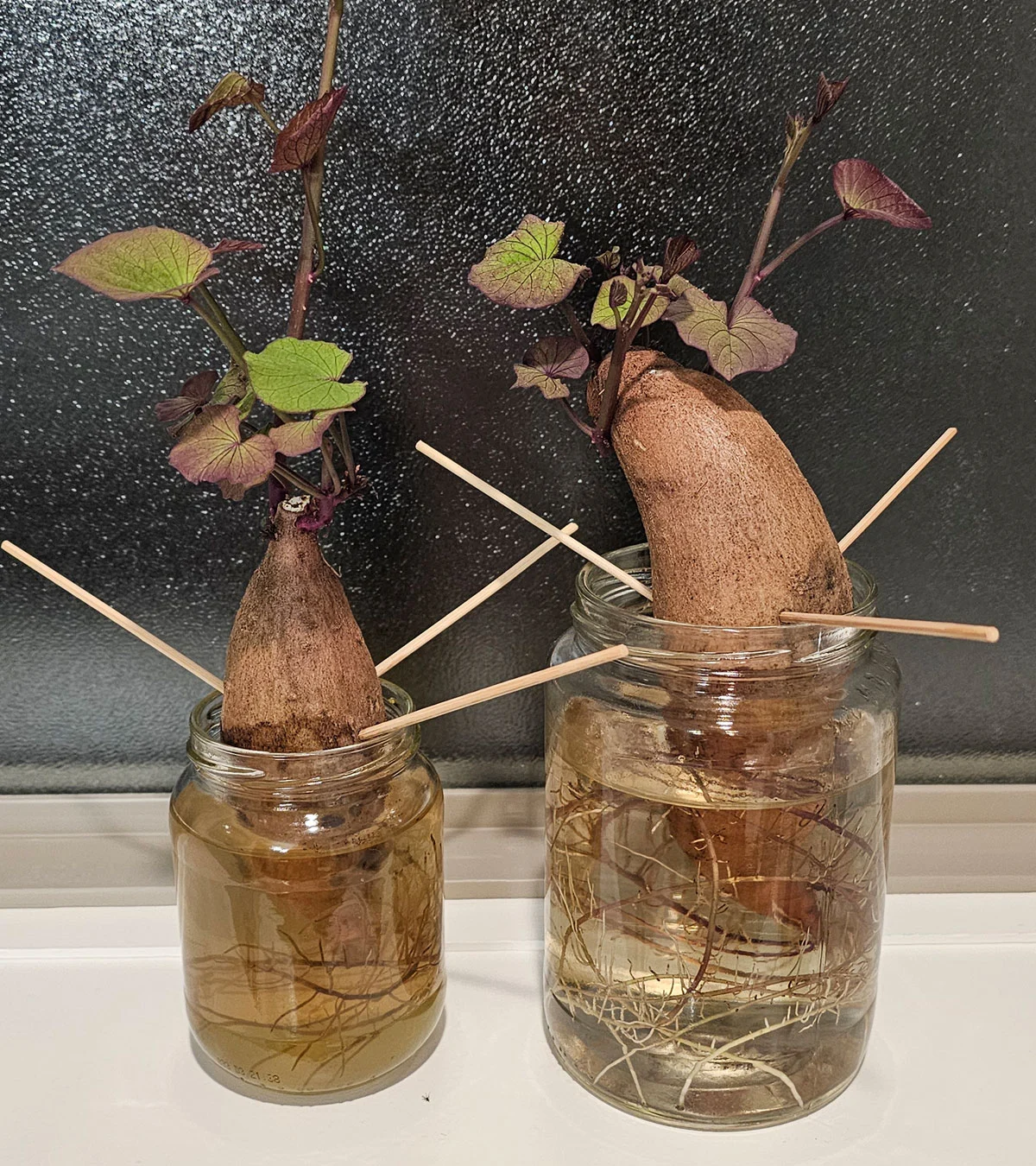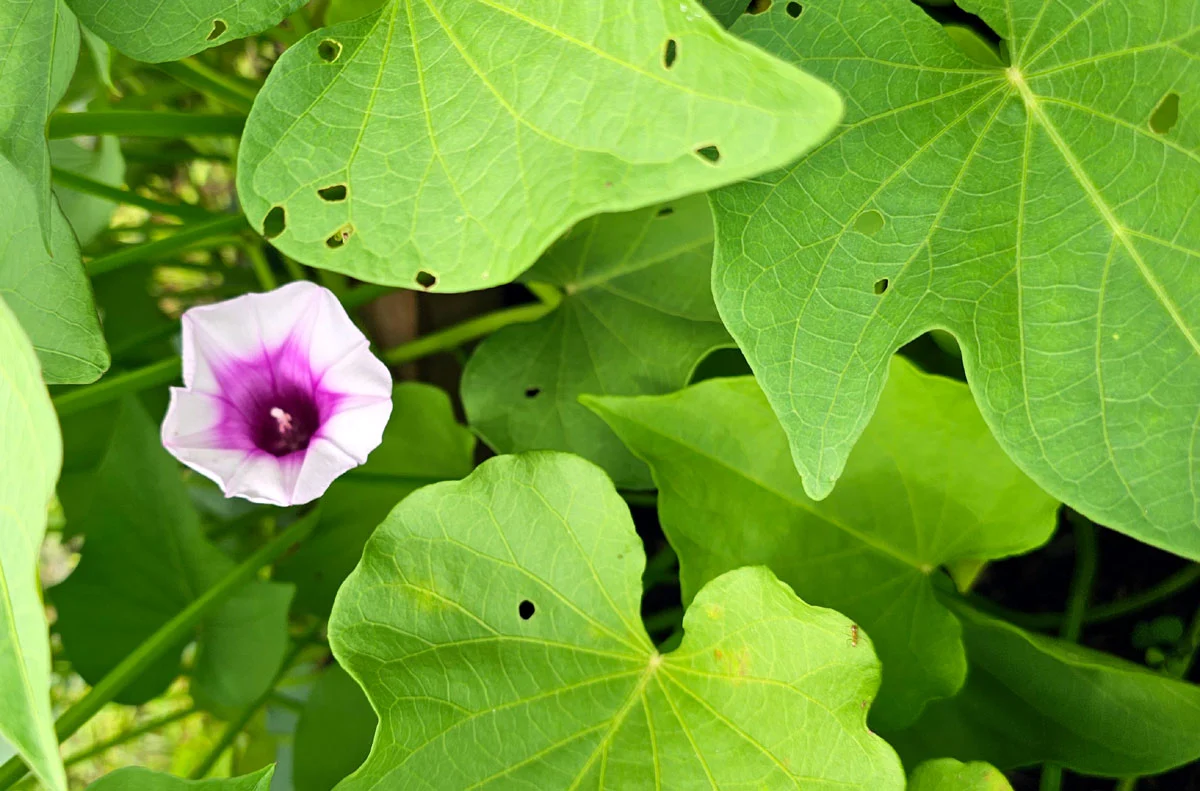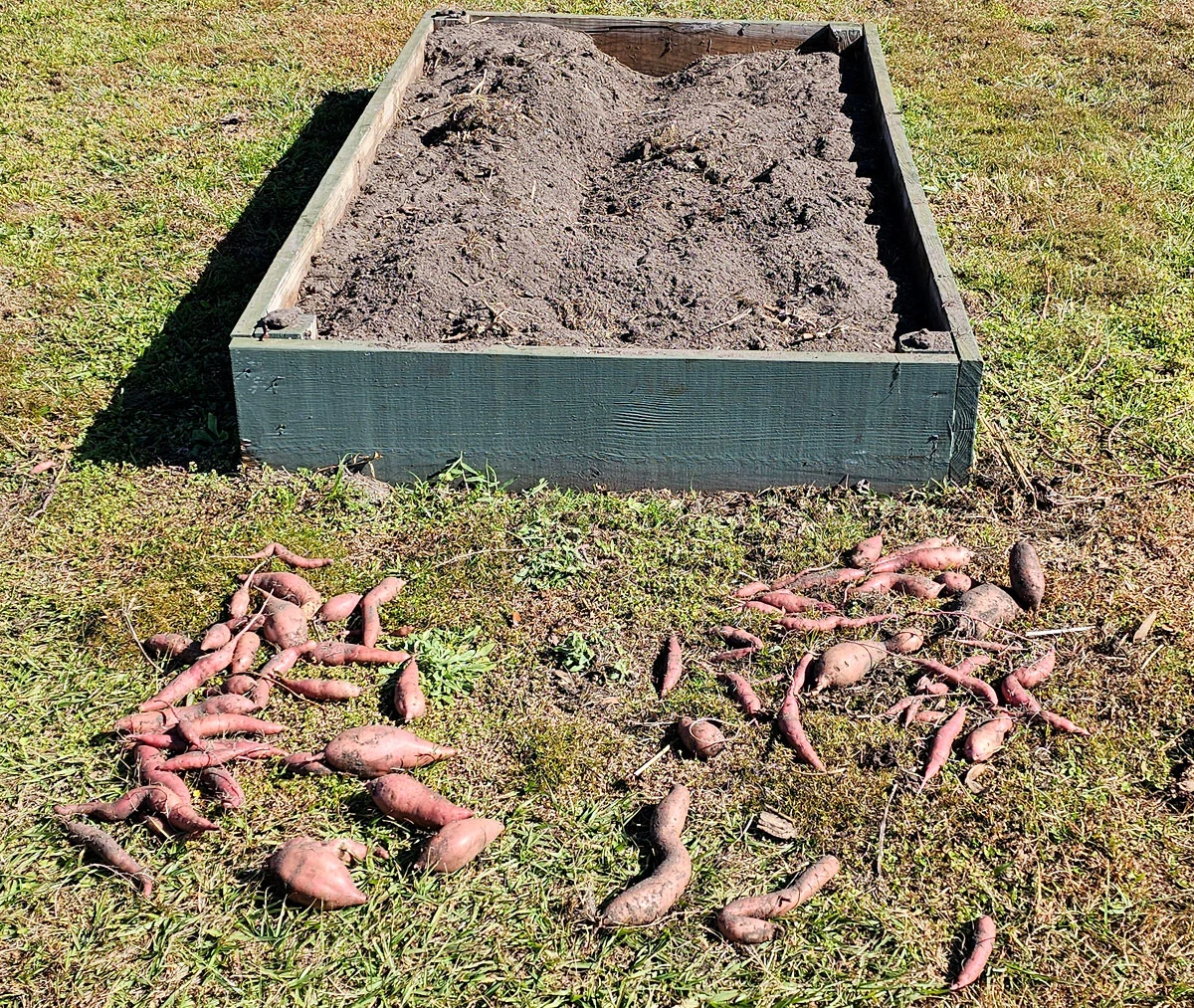Sweet potatoes are one of the easiest, most rewarding crops you can grow in Florida — if you learn how to work with our challenging sandy soil. These hearty root vegetables actually like Florida’s heat and humidity, and can thrive with just a few simple adjustments.
So, if you’ve got Florida sand and dreams of a bountiful sweet potato harvest, this post is for you. Let’s dig in!

What We’ll Cover
- Why sweet potatoes are great for Florida gardens
- How to prepare your sandy soil or raised beds
- How to grow sweet potato slips
- Planting sweet potato slips
- Tips for growing strong, healthy vines
- Managing pests and disease
- When to harvest and storage tips
- Final Thoughts
- FAQs
Why Sweet Potatoes are Great for Florida Gardens
Sweet potatoes are a warm-season crop that loves long, hot summers, making them a perfect match for our climate. They’re drought-tolerant, pest-resistant (to a point), and can even improve your soil over time thanks to their sprawling vines and tuber-producing roots.
These tasty tubers can be planted in the spring when the soil begins warming through the end of June. Some of the best Florida-friendly varieties are Centennial and Beauregard. If you prefer a more bushy and less sprawling vine, consider the Vardaman variety.
While they can be grown in pots and raised beds and are prolific in food forest systems, today’s focus will be on growing them in our typical in-ground sandy soil.
How to Prepare Your Sandy Soil
If your soil is more beach than bed, don’t worry – you don’t need to replace it. You need to build it up. Sandy soil drains fast and lacks the nutrients sweet potatoes need to truly thrive. My first year growing them in Florida soil produced tiny tubers -if any! I turned to our state’s extension service for help and made several improvements that increased my yields the following season. I now grow sweet potatoes in raised beds with a mixture of native soil(sand) and the following amendments.
Here are some of the best ways I’ve learned to prepare your soil for sweet potatoes:
- Add organic matter. Compost, rotted leaves, or aged manure help sandy soil retain water and nutrients. Work up the soil around the hole about 8 – 10 inches deep, and combine the organic matter with your sandy soil. I suggest at least 50% organic matter and 50% native soil. What we’re trying to achieve is a sandy loam soil.
- Mix in coconut coir or peat moss. These lightweight materials help hold moisture and reduce that “dry in a day” effect. Add in about 10% – 20% in addition to your organic matter.
- Enrich the soil with some worm castings or a mild, organic fertilizer. Sweet potatoes don’t need heavy feeding, but they’ll appreciate a nutrient boost at planting time. I use a diluted organic fish emulsion-based liquid fertilizer.
Tip: These are just guidelines. It takes time to build a good garden bed. Sweet potatoes love sandy soil, but too much fertilizer, especially nitrogen-based, will produce an abundance of vines, but little for tubers.
How to Grow Slips

Sweet potatoes aren’t grown from seeds — they’re grown from slips, which are little sprouts from a mature sweet potato. You can buy slips online from seed companies like Botanical Interests or Park Seeds. Or, you can grow your own using this method:
Steps to Grow Your Own Slips:
- You’ll need a sweet potato (preferably organic), a glass jar, wooden picks (toothpicks or short bamboo skewers), and a sunny area to place it.
- Place the sweet potato in a container of water with the root side down and the sprouting side up. (photo). I like to suspend the sweet potato about half in water, and half above. It’s important to have the rooting side in the water. Examine the tuber closely. The root end is typically more tapered, while the sprouting end is more rounded and will have tiny eyes, like on an Irish potato.
- Let it sit on a windowsill in a sunny room or under a grow light. Make sure it’s warm. You may need to keep it on a heat mat, like those used for seed starting.
- Once the vines sprout and have several leaves on them, gently cut them off.
- Pinch off all but the top 3-4 leaves and place them in a jar of water to root.
- Once they develop a strong root system, they’re ready to plant.
Use this Sweet Potato Slip-Starting Checklist for quick reference.

Planting Sweet Potato Slips
Rooted slips can be planted in your prepared beds once the danger of frost has passed — usually March to June in most of Florida. In the more southern part of our state, you can grow sweet potatoes almost year-round.
The soil should be at least 65°F, and the evening temperatures should be above 55°F. The pH level of your soil should be between 6.0 to 6.5. However, I have sweet potatoes growing year-round in our food forest. The vines die back in the winter, and I’ll usually see them reappear in March, about the same time as the maypops show up.
Whether you’ve grown your own or ordered from a nursery, this is the best method I’ve found for planting in sandy soil.
- Pinch off the lower leaves, leaving just the rooted vine and about 5-6 leaves at the top.
- Dig a hole in your prepared soil about 4-6 inches deep.
- Lay the roots and vine in the soil and cover, leaving just the leaves showing above ground.
- Water thoroughly. Water as needed the first 2 weeks until the root system is established and the vine is growing new leaves.
- I usually wait a week, then water the vines with a diluted organic fertilizer.
After that, the vines are practically care-free! Just keep them watered as needed during the dry season.
Growing Strong, Healthy Vines
Sweet potato vines love to ramble. They’ll take off across your garden if you let them! I’ve had them overflow my raised beds and take root in the grass around the beds. Be sure to plant them where they have plenty of space to spread.
Here are some best practices for growing your vines over the hot summer:
- Spacing: Plant slips 12–18 inches apart in rows about 3 feet apart. Give them plenty of space to spread. They’ll put down roots where the nodes touch the soil, which will help them grow.
- Watering: Keep the soil consistently moist (especially in the first 30 days), then back off. Too much water late in the season can cause rot. Unless it’s a dry year, Florida’s rainy season usually keeps them happy.
- Mulching: Helps retain moisture and suppress weeds.
- Fertilizing: About a month after planting, you can help them out with some organic fertilizer, depending on how much you enriched your sandy soil before planting. Use a fertilizer that’s low in nitrogen, like a 5-10-10.
- Pruning: There are several reasons you may wish to prune vines during the growing season. You may need to remove excess foliage, damaged leaves, or keep the sprawling vines in check. Often, I’ll just reroute the direction the vines are growing instead of pruning. Laying the nodes on the soil encourages tuber growth.
- Weeding. As needed. Once they get growing, the leaves will shade the soil, which helps prevent new weeds from sprouting.
Managing Pests and Diseases
Sweet potatoes are pretty pest-resistant, but there are a few troublesome pests and diseases you need to be aware of.
Pests:
- Whiteflies or aphids. I find them every year on the leaves of my sweet potato vines. They’re usually not a problem, and I’ll let them be; however, once in a while, I’ve needed to use some neem oil spray to manage the spread of the pests. But since we like to eat the leaves (they’re great in a salad or steamed like spinach!), I try not to use any chemicals on our plants.
- Nematodes. These microscopic creatures are everywhere in our Florida soil. The troublesome ones to watch for are the root-knot nematodes. They’ll prevent the roots from up-taking nutrients from the soil. You can mitigate their damage by growing nematode-resistant varieties and heavily amending the sandy soil with plenty of organic matter.
- Sweet potato flea beetles. The adults of these little pests eat tiny holes in the leaves, while the larvae eat the hair roots and tubers, leaving tiny pitted holes. (photo).
- Other pests. Watch for white grubs, cucumber beetles, thrips, and wireworms. While I haven’t encountered these, they are a potential threat. If you have good soil, chances are you won’t have too many pest problems.

Diseases:
- Black rot. This is one of the most common diseases that attack sweet potatoes. It’s caused by a soil-borne fungus called Ceratocystis fimbriata.
- Fungal blights. Varieties of fungi such as Alternaria spp and Alternaria bataticola can attack sweet potato leaves. They show up as brown rings resembling a bullseye on the leaves. To prevent fungal blights, make sure there’s plenty of air flow between the leaves and the ground is not too wet.
- Fusarium Wilt and Fusarium Root Rot. These are similar to the blight varieties and can be controlled or prevented in the same way.
When to Harvest and Storage Tips

Sweet potatoes take about 90 to 120 days to mature. You’ll know it’s time when:
- The leaves start to yellow and die back.
- It’s been 3–4 months since planting.
- You can’t wait any longer and just start digging to see what’s down there. (No judgment — I’ve been there.)
Use a garden fork or your hands to gently lift the tubers. Dust them off, but do not wash them. Cure them in a warm, dry place, preferably on a rack for good air flow, for a week or two to improve flavor and shelf life.
Final Thoughts
Florida sand doesn’t have to hold you back from growing a great crop of sweet potatoes. With just a little soil-building and the right timing, you can enjoy a healthy harvest.
Ready to Grow?
Have you tried growing sweet potatoes in your sandy garden? What’s worked best for you? Let me know in the comments — or share a photo of your sweet potato patch on social media and tag me: @ourfrugalflhomestead!
FAQs
No, sweet potatoes (Ipomoea batatas) and yams (Dioscorea species) are entirely different plants, even though the names are sometimes used interchangeably in the U.S. Sweet potatoes are part of the morning glory family and have smoother skin with flesh that can be orange, white, or purple. True yams are starchy tubers native to Africa and Asia, with rough, scaly skin, and are botanically unrelated to sweet potatoes. While true yams can occasionally be found or grown in South Florida, most “yams” sold in American grocery stores are actually varieties of sweet potatoes.
Yes, sweet potatoes are very sensitive to cold. Even a light frost can damage or kill the vines, and a hard frost can ruin the developing tubers underground. In Florida, it’s important to plant sweet potatoes after all danger of frost has passed in the spring. As fall approaches, keep an eye on the weather — if a frost is predicted, it’s best to harvest your sweet potatoes beforehand. If that’s not possible, you can try covering the vines with frost cloth for temporary protection, but it’s safest to dig them up once temperatures start to dip below 50°F consistently.
Growing sweet potatoes near coastal areas where saltwater is a concern can be tricky. Sweet potatoes don’t tolerate salty soil well, so it’s best to avoid planting them too close to salty areas or consider soil amendments that can help reduce salt levels.
Yes! While sweet potatoes are fairly low-maintenance, crop rotation is always a good practice. Rotating your sweet potato plants with other crops helps prevent soil depletion and can reduce the build-up of pests or diseases.
Leave a Reply